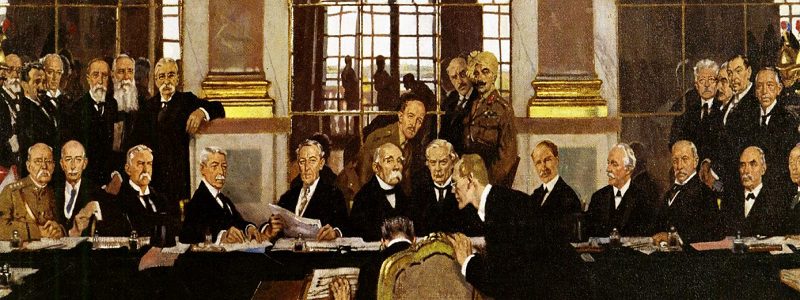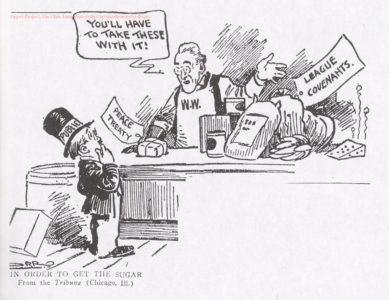
Evidence Rating and the Treaty of Versailles
Regular readers of The Debatifier know that argument-centered curricular resources, projects, and activities come in all shapes and sizes. Longer-term classroom debate projects can be extremely powerful learning engines, while on a shorter, smaller scale, argumentation activities can be woven into or deployed several times over the course of any given week in any high school or middle school classroom. Educators who have the enhanced professional capacity to teach subject area content and skills objectives through academic argumentation and debate can, in a literal way, do both. They are mutually reinforcing.
We have been working with one of our partner schools’ humanities teachers on a World War I unit. The teachers wished to develop a mid-size structured argumentation component for the unit’s study of the war’s end, the controversial Treaty of Versailles.
A Short History of the Treaty of Versailles
The Treaty of Versailles officially ended World War I when it was signed by the Big Three allied partners – France, Great Britain, and the United States (Italy withdrew before signing) – on June 28, 1919, in the Hall of Mirrors in Paris. The Treaty took months to negotiate, and that was without the presence of German negotiators (who were barred because of their status as enemies during, and instigators of, the war), though there were hundreds of diplomats from a large number of European nations involved.
Germany and Austria-Hungary lost more than 3 million men in the “war to end all wars,” but France itself lost nearly half that number, and had another 2.5 million soldiers wounded, and for this and other reasons France pushed hard during the negotiations for an outcome that would have Germany pay severe reparations and for the German war machine to be permanently smashed. While France forwarded a highly anti-German hardline, Great Britain wished to prop Germany back up to some extent, looking for a buffer and counter-weight to the possibility of a revived and remilitarized Russia after the war. Badly damaged by the war, Italy advocated for its own interests, seeking a more narrow restoration of its territorial and financial losses.
The United States, under the presidency of Democrat Woodrow Wilson, pursued an idealistic vision of a world that could be healed and nations that could learn from the horrible lesson of World War I that there was no sane alternative to peaceful co-existence. Wilson advocated for a set of Fourteen Points that codified his vision, though the only point that made it to the final version of the Treaty was his call for a League of Nations, a forerunner to the United Nations founded after World War II in 1945.
Negotiations concluded with a compromise among the Allies. The final Treaty of Versailles had Germany paying billions of dollars in reparations (of $5 billion), though the enforcement provision for those payments was not strong. Germany gave up significant territories, but most of those they had captured during WWI. Their war machine was damaged and then kept small, but not permanently.
The Debatable Issue
Historians have debated, with increasing volume, about the Treaty and its effects, particularly of course on the German economic and political system and the lead-up and causes of World War II. The debatable issue for this activity is a formulation of this historical question.
Was the Treaty of Versailles a relatively balanced and just agreement, given Germany’s actions during WWI, or was it overly harsh and ineffective, creating the conditions that led to the rise of Nazism and the start of WWII?
In this activity students will focus on the evidence that supports various claims made on both sides of the issue. They will examine the evidence closely and carefully, and think through its qualities relative to the criteria for effective use of evidence in academic argument. Students will rate each piece of evidence on this criteria and then justify their ratings. Finally, students will share their ratings with a partner, paying special attention to the instances in which they disagreed in their ratings, coming to a consensus or agreeing to disagree on their ratings. Student pairs will share out in a classroom-wide discussion of the evidence – its implications for unit content knowledge and its representative functioning in academic argumentation.
Evidence Rating: Process and Method
(1)
Screen the Treaty of Versailles video twice, asking argument-based questions in between screenings.
(2)
Each student should be given a copy of the Evidence Rating System and the Evidence Rating Form.
(3)
The teacher should review the criteria for the effective use of evidence in academic argument. Models and exemplars should be given to illustrate effective and less effective use of evidence for each criterion.
(4)
Students should be given about 25 minutes to compete the Evidence Rating Form. They should work independently, with the teacher circulating to answer questions, give suggestions, and monitor work.
(5)
Students should then be paired up (even if they are not fully finished). In pairs they should discuss their ratings and justifications, paying special attention to the instances in which their ratings differed. They should see if they come to a consensus on a rating, or agree to disagree.
(6)
Pairs should be asked to share out. The teacher should lead a classroom-wide discussion. Students should turn in their Evidence Rating Forms for formative assessment.
Evidence Rating System
Students will use the system below to rate each piece of evidence on each criteria for the effective use of evidence in academic argument. The ratings are on a 5-point scale, so students will put a number in each criterion box. The rating descriptors are as follows:
5 — Highly effective, impressive, persuasive, needs little to no improvement
4 — Effective, solid satisfaction of the criterion, but some improvement possible
3 — Mixed, partially effective, partially ineffective, something to build on but in need of significant
revision/improvement
2 — Minimally effective, flawed, insufficient satisfaction of the criterion, should be
substantially revised/improved
1 — Highly ineffective, highly flawed example of argumentation, should be fully
re-written or re-worked
Criteria for Effective Use of Evidence
There are four basic criteria for the effective use of evidence in academic argument.
Alignment (A)
Is the evidence presented closely aligned with the argumentative claim? Does it directly support the specific claim being made, or is it imprecisely aligned or not relevant?
Credibility (C)
Is the evidence from a credible source? Or is the source biased or lacking credentials? Is the evidence authoritative? Does it contain internal credibility – meaning, does the paraphrase or quote include the warrants for the source’s viewpoint, or is it declarative without explaining the basis for its conclusion?
Sufficiency (S)
Is the evidence sufficient to make the claim convincing? Is the evidence credible? Are its sources authoritative? Are its sources varied, or are the sources too narrow?
Reasoning (R)
Is each piece of evidence accompanied by a clear and convincing explanation as to how it proves the claim? Does the reasoning demonstrate thoughtfulness and insight? Does the reasoning advance the argument?
Sample Argument on the Treaty of Versailles
The full activity has a set of arguments on both sides of the debatable issue on the Treaty of Versailles, the evidence supporting which students rate using each of the four primary criteria for the effective use of evidence in academic argumentation.

This is a sample of the argumentation that students rate.
Argumentative Claim
The billions of dollars in reparations that Germany was required to pay in the Treaty of Versailles caused a depression in Germany that opened the door for the rise of Nazism in the 1930s.
Evidence and Reasoning
One of the foremost economists of the 20th century, John Maynard Keynes, wrote in The Economic Consequences of Peace (1920), that, “I believe that the campaign for securing out of Germany the general costs of the war was one of the most serious acts of political unwisdom for which our statesmen have ever been responsible.” Keynes would eventually become one of Time magazine’s 100 most important people of the century for his development of a highly influential economic theory of the role of government in the economy. During World War I he worked for the British Exchequer (akin to the American Treasury Department), and in that role he believed that the Treaty of Versailles was asking Germany to pay reparations many times more than it was possible for the country to pay. Punishing Germany so severely may have resulted in the very weak economy that Germany experienced in the 1920s and 1930s. It’s not hard to imagine that the German people were more open to Nazi propaganda and appeals because they were suffering economically.
Ratings
Rate the evidence above on each of the four criteria and justify each of your ratings.
A: [ ]
C: [ ]
S: [ ]
R: [ ]

